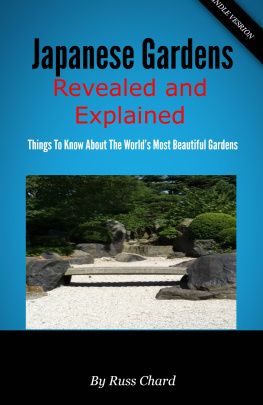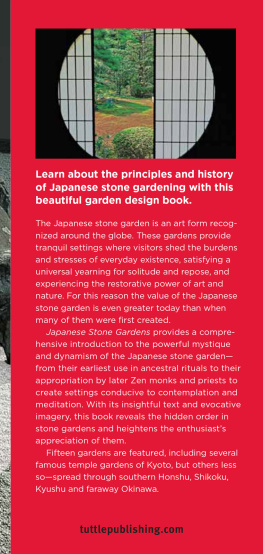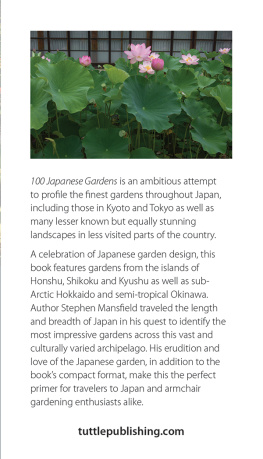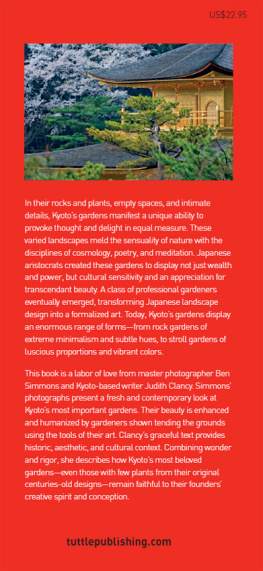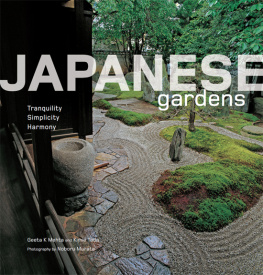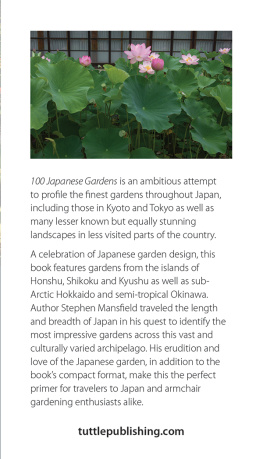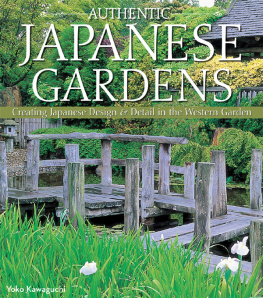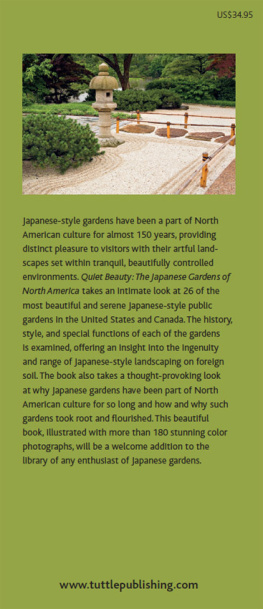Copyright 2013 by Zenibo Marketing Ltd
All rights reserved. No part of this book may be reproduced in any form or by any electronic or mechanical means including information storage and retrieval systems except in the case of brief quotations in articles or reviews without the permission in writing from its publisher, Zenibo Marketing Ltd
All brand names and product names used in this book are trademarks, registered trademarks, or trade names of their respective holders. We are not associated with any product or vendor in this book.
Introduction
Whether you are an established enthusiast of Japanese and Zen gardens or are maybe simply interested in creating one, however large or small, this manual will provide invaluable assistance to help you achieve your garden dreams.
Japanese Gardens Revealed And Explained is a definitive guide to learning all about Japanese and Zen gardens too!
Dont worry in the slightest if you havent got green fingers because it doesnt matter one iota. My book will help you appreciate and understand exactly what they are, why they are the way that they are and provide you with a wealth of knowledge into the bargain.
Creating a Japanese garden can be comparatively simple but the more ambitious that you are the more complicated the job can become.
Its not just about placing plants, shrubs, rocks and water features in a random fashion in your yard or garden and thinking thats it.
Some people quite rightly refer to Japanese / Zen gardens as works of art and this is the thinking you should be put into the creation or maintenance of your own garden. Therefore, you have to decide what you are going to put into your garden and why.
There are numerous elements that are important to the design of a Japanese garden such as elements and defining characteristics.
This book is not a design manual for such a garden but a guide to what elements should make up a Japanese garden plants, shrubs, trees, water features and plants. Master garden architect Albert D Taylor, M.S.A. gives you the benefit of his years of experience to help and inspire you with suggestions and ideals.
Zen gardens are covered fully too, these follow very specific design rules as well but the good news is they are easy to build and you dont need a big space in which to do it!
Predominantly, this book is about Japanese gardens and reflects the elements that you need to achieve that tranquil haven that you desire with good sound advice. No technical gobble de gook, just helpful hints and tips! You wont find it clogged up with pictures either it is just the information that hopefully you will need.
I hope you find it both inspiring and useful. Good Luck!
Russell Chard-Editor

Continue Reading >>>
Japanese Gardens
A History
The Japanese tradition is to revere nature and their gardens always are meant to be quiet retreats away from the stresses and strains of everyday life.
A common factor in some types is that they are meant to be viewed from one area to take in the views, ingredients and over time the changing seasons.
The 3 basic elements of Japanese gardens are:
Water
Rocks
Plants/ Trees
There are other sub-elements but I will get onto them further on in this book.
The history of Japanese gardens goes back hundreds of years and it is now accepted that they actually mostly derived in China.
Many hundreds of years ago the Chinese started designing recreational gardens and as they developed news of these structures and their ingredients spread.
Gardening was almost a philosophy and its fair to say reached its peak in ancient times in Japan. The Japanese created a sort of light version of Chinese gardens, for want of a better term, they distilled what the Chinese had done to suit their own culture and beliefs.
The Japanese imported these garden ideas from China during the period known as the Han Dynasty.
Emperor Wu Di who lived from 140-87 BC first created a garden containing 3 small islands.
These were meant to represent the Isles of the Immortals who were considered to be Toaist gods, this set a trend for all gardens to concentrate on replicating the land of legend.
Japanese gardens today mimic nature but this was not the case during the Han period. The only gardens built were to display mythical lands and landscapes. So there was a good deal of imagination being used!
The first hill and pond garden in Japan was established in the early 600s AD when the Chinese Emperor Yang Di enjoyed relations with Japan at his instigation.
The Japanese responded to these overtures and sent an envoy to China who was a man called Ono no Imoko. He became immersed in China and its culture and met with the emperor on many occasions.
Upon his return to Japan he took with him much of what he had learnt and the art of gardening was just one subject he was keen to relate to the Japanese hierarchy and people. Another idea imported to Japan at the same time was Buddhism.
The Shinto Tradition: Asuka era
During this period the appreciation of the Shinto belief started to take a small hold in Japan. The Shinto religion looked upon nature as a god (s) and certain types of rocks and trees were openly worshipped.
A rice straw rope was used to seal off the deity rock or stone pronouncing the area as a holy piece of land where nature and man were at one.
The word NIWA in Japanese is a cultivated field but it is also the term that they used to call the holy piece of land around a stone or tree. So in essence, these were the Japanese gardens of the Asuka era, certainly during the period 552-646AD.
The Nara Era- 646-794AD
This was really the time in Japanese history that the Chinese ideology started to blend in with Japanese life and traditions.
In fact, the word niwa first appeared in the Japanese language during this period, previously it was Chinese expression for the type of holy sites mentioned previously.
The garden architecture of this period used walkways- often between buildings and they also used stones and shrubs to actually compliment the buildings themselves. More often than not, the buildings were Royal palaces or shrines and temples.
These types of gardens are known as Shinden.
Buddhism and its teachings were pretty common in Japan during this period and Shumisen became common. This is a Buddhist representation of the centre of the universe and in the garden a central large stone would be placed to indicate the home of the Buddha.
Surrounding this central stone would be a collection of smaller ones that would depict the Buddhas disciples.
The Heian Era
This period was from 794 to 1185AD and is accepted as being the period of opulence and luxury in Japan. Elegance was the requirement of the day.
Japanese gardens developed into much larger and opulent creations and were usually the domain of the rich and the famous. They were status symbols.
Moneyed people were expected to know all about garden design sticking to the now well-developed rules. Viewing gardens were popular and water features such as ponds allowed the owners to spend their time messing around in boats.
It is during this period that the first shoots of what we now know as modern Japanese gardening first appeared. Tachibana no Toshitsuna wrote the book of garden or

